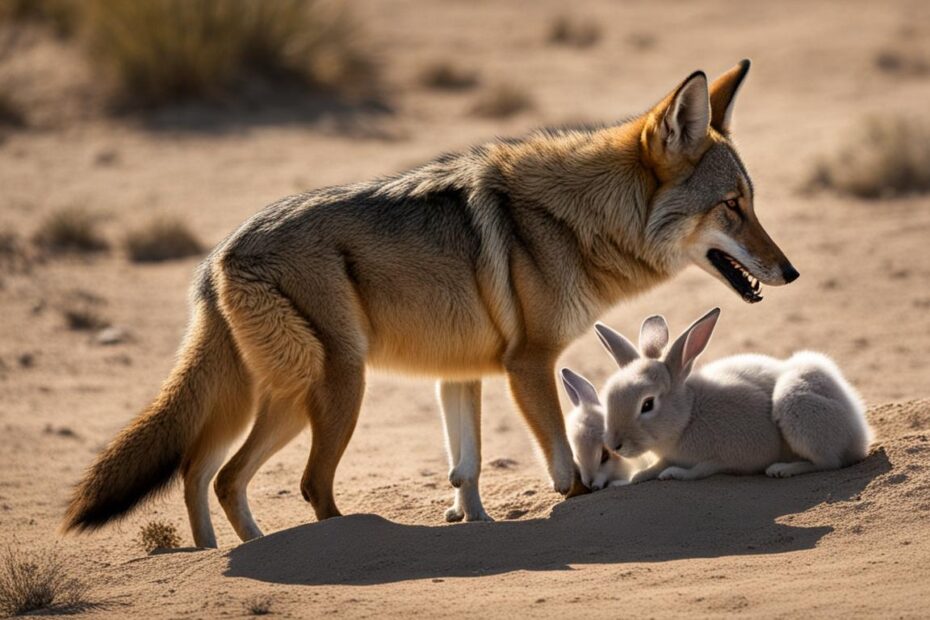Coyotes, as cunning predators, have a diverse diet that includes rabbits. Their relationship with rabbits is an intriguing example of the predator-prey dynamic in the natural world. Understanding the coyote’s hunting techniques and the impact of their predation on rabbit populations provides valuable insights into the delicate balance of our ecosystem.
Key Takeaways:
- 1. Coyotes are known to consume rabbits as part of their diet.
- 2. They employ both the ambush and chase methods to catch rabbits.
- 3. Coyote predation regulates rabbit populations and maintains ecological balance.
- 4. Rabbits have evolved camouflage and acrobatic abilities to evade coyote predation.
- 5. Urban coyotes adapt to human food sources, including garbage and domestic cats.
The Ambush Method
Coyotes are skilled hunters that employ various techniques to catch their prey, including rabbits. One of their most effective strategies is the ambush method. This technique involves the coyote patiently lying in wait, using its natural instincts to blend into the environment and choosing the perfect moment to strike.
One of the key elements of the ambush method is the coyote’s patience. These intelligent predators can wait for hours, remaining perfectly still until the perfect opportunity presents itself. They rely on their keen senses and ability to blend into their surroundings to remain undetected by their unsuspecting prey.
Coyotes are masters of camouflage, using their fur coloration and natural patterns to blend seamlessly into the surrounding vegetation. They often take advantage of natural cover, such as dense bushes or tall grass, to conceal their presence. This camouflage allows them to get close to their prey without being noticed, increasing their chances of a successful hunt.
The Ambush Method – Step by Step
- Choose a strategic location with good visibility of the surrounding area.
- Lie down and remain completely still, using camouflage to blend into the environment.
- Use patience and wait for the perfect opportunity to pounce.
- Make a quick and decisive move to catch the unsuspecting rabbit.
- Use their sharp teeth to deliver a lethal bite to the neck or head.
“The coyote’s ability to patiently lie in wait and blend into its surroundings is truly remarkable. It is a testament to their adaptability and hunting prowess.”
| Advantages of the Ambush Method | Disadvantages of the Ambush Method |
|---|---|
| Requires patience and stealth | Risk of detection by prey |
| Allows for close proximity to prey | Relies on favorable environmental conditions |
| Increases chances of a successful hunt | Dependent on the element of surprise |
| Minimizes energy expenditure | Not suitable for all hunting situations |
The ambush method is a testament to the coyote’s adaptability and hunting skills. By utilizing patience, camouflage, and strategic timing, coyotes are able to effectively catch rabbits and other prey. This hunting technique allows them to conserve energy and increase their chances of a successful hunt, ensuring their survival in the wild.
In the next section, we will explore another hunting technique employed by coyotes: the chase method. This high-speed pursuit requires agility and quick reflexes, making it an intriguing aspect of coyote hunting behavior.
The Chase Method
Coyotes employ various hunting techniques to catch their prey, including rabbits. One of the most common methods used by coyotes to chase rabbits is their remarkable speed and agility. Coyotes can reach speeds of up to 40 miles per hour, allowing them to quickly close the distance between themselves and their quarry. This impressive speed gives them an advantage when pursuing rabbits.
The chase begins when a coyote detects a rabbit. With their acute senses, including sharp eyesight and hearing, coyotes can track the movements of their potential prey. Once they spot a rabbit, they give chase, relying on their agility to navigate the terrain and keep up the pursuit. Coyotes can make sharp turns, quick accelerations, and sudden stops, allowing them to stay on the heels of their prey.
Rabbits, on the other hand, have their own set of escape tactics to evade coyotes. They rely on their ability to change direction rapidly and make sudden, unpredictable movements. By zigzagging and leaping erratically, rabbits make it challenging for coyotes to maintain a steady pursuit. This agile behavior can buy them precious time to find cover or escape into their burrows, which are inaccessible to coyotes.
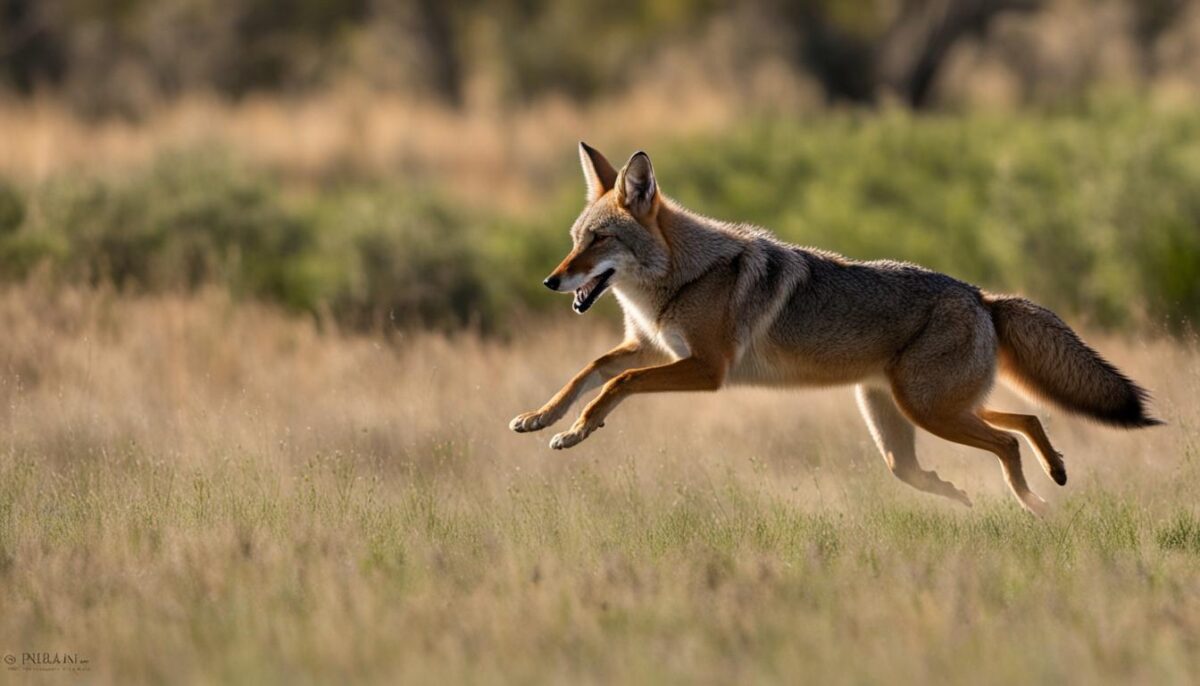
The Role of Speed and Adaptability
Speed and agility are crucial for both coyotes and rabbits in their predator-prey relationship. Coyotes have evolved to be swift hunters, relying on their ability to chase down their prey. Conversely, rabbits have developed incredible agility to outmaneuver their predators, such as coyotes. This perpetual cycle of adaptation ensures the survival of both species.
By understanding the chase method employed by coyotes and the escape tactics used by rabbits, we gain insight into the intricate dynamics of the predator-prey relationship. These dynamics play a vital role in the overall balance of the ecosystem, shaping the behavior and survival strategies of both the predators and their prey.
Clever Strategies
Coyotes are highly adaptable predators and employ a range of clever strategies in their pursuit of rabbits. One such tactic is their ability to hunt in packs, demonstrating impressive teamwork to outmaneuver their prey. By surrounding the rabbit, they increase their chances of a successful capture. This collaborative approach is an evolutionary advantage for coyotes, allowing them to overcome the agility and speed of their rabbit quarry.
Additionally, coyotes are quick to identify and exploit the vulnerabilities of rabbits. They observe and take advantage of when rabbits seek shelter in burrows, utilizing their intelligence to devise ways to infiltrate these hiding places and secure their meal. This adaptability and resourcefulness showcase the ingenuity of these predators in their quest for sustenance.
Another fascinating aspect of coyote hunting strategies is their ability to adapt to different environments. Urban coyotes, for example, have learned to navigate human-populated areas, making use of human food sources. This adaptation to urban environments has allowed them to thrive, as they scavenge for garbage and even hunt small domesticated animals, such as cats. This demonstrates their ability to capitalize on new opportunities presented by human activities, further reinforcing their status as cunning and adaptable hunters.
Overall, the clever strategies employed by coyotes showcase their intelligence and flexibility as predators. Their pack mentality, exploitation of vulnerabilities, and adaptation to urban environments all contribute to their success in capturing rabbits and securing their place in the ecosystem.
The Impact of Coyote Predation on Rabbit Populations
The predator-prey relationship between coyotes and rabbits has a significant impact on rabbit populations and plays a crucial role in maintaining ecological balance. Coyote predation exerts selective pressure on rabbits, leading to the development of adaptations that enhance their survival chances.
Rabbit adaptations: In the face of coyote predation, rabbits have evolved several strategies to increase their chances of survival. These adaptations include enhanced agility, rapid movements, and the ability to camouflage themselves with their surroundings. By blending in or standing out, rabbits can effectively evade detection and escape from their predators.
“The relationship between coyotes and rabbits is an ongoing cycle of adaptation and survival.”
Fluctuations in rabbit populations due to coyote predation can have cascading effects on the ecosystem. When rabbit populations are high, more food resources are consumed, which can impact vegetation and other wildlife. Conversely, when coyote predation reduces rabbit populations, vegetation can experience less grazing pressure, allowing it to recover and thrive.
The Role of Ecological Balance
Ecological balance is essential for the sustainability of ecosystems. The predation of rabbits by coyotes helps maintain this balance by regulating rabbit populations. Without the presence of coyotes, rabbit populations may become overabundant, leading to resource depletion and potential negative impacts on other species within the ecosystem.
| Coyote Impact | Rabbit Adaptations |
|---|---|
| Regulates rabbit populations | Enhanced agility |
| Maintains ecological balance | Rapid movements |
| Cascading effects on the ecosystem | Camouflage with surroundings |
The predator-prey relationship between coyotes and rabbits highlights the interconnectedness of species and the importance of maintaining a healthy and resilient environment. As coyotes continue to exert selective pressure on rabbits, rabbit populations will continue to adapt, leading to an ongoing cycle of survival and evolution.
Rabbit Camouflage: Blending In or Standing Out!
When it comes to survival in the wild, rabbits have evolved remarkable camouflage techniques to evade predators. These adaptations allow them to either blend in with their surroundings or use flashy colors to startle their pursuers and make a quick escape.
Rabbit camouflage comes in two primary forms: cryptic coloration and flash coloration. Cryptic coloration refers to the ability of rabbits to blend in with their environment through natural coloring that matches their surroundings. This can include hues of brown, gray, and green, allowing them to hide effectively in grassy fields, forests, or rocky terrains.
On the other hand, flash coloration involves the use of bright and contrasting colors to startle and confuse predators. When threatened, some rabbit species have the ability to display vibrant patches of white fur on their tails or other prominent parts of their bodies. This sudden burst of color can momentarily distract predators, giving the rabbit a chance to flee from danger.
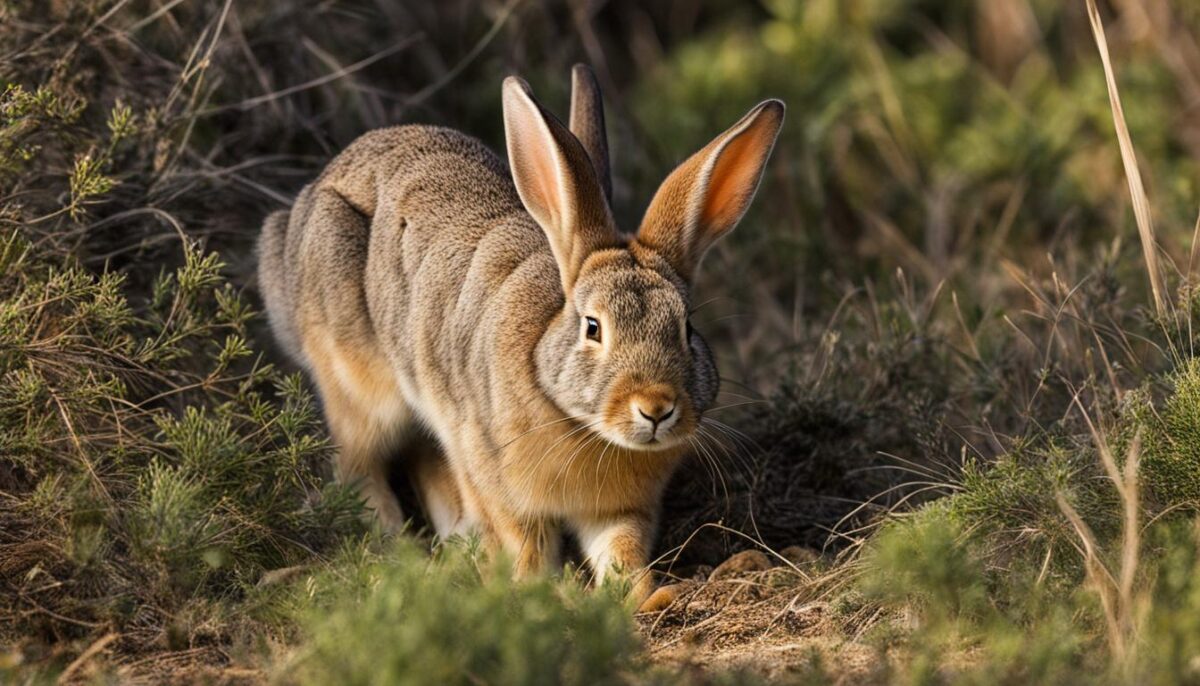
Table: Rabbit Camouflage Techniques
| Camouflage Technique | Description | Examples |
|---|---|---|
| Cryptic coloration | Rabbits blend in with their surroundings by matching the colors of their environment. | Gray rabbits in rocky areas, brown rabbits in grassy fields |
| Flash coloration | Rabbits startle predators with sudden bursts of bright and contrasting colors. | Rabbits with white tail patches or vibrant markings |
Rabbit camouflage not only helps them avoid becoming prey but also plays a crucial role in their ability to find food. By remaining inconspicuous, rabbits can venture out to graze or forage without attracting the attention of predators. This survival strategy has allowed them to thrive in various habitats across the globe.
Rabbit Agility and Rapid Movements
Rabbits are highly agile creatures, known for their lightning-fast speed and remarkable acrobatic abilities. Their agility allows them to swiftly maneuver through various terrains, making it challenging for predators like coyotes to catch them. With their powerful hind legs and flexible bodies, rabbits can leap, change direction rapidly, and execute impressive jumps to evade potential threats.
Their rapid movements enable them to quickly change their position, often zigzagging or darting away in unpredictable patterns. This agility, combined with their exceptional speed, gives rabbits a significant advantage when it comes to escaping from predators. They can utilize their quick reflexes and evasive maneuvers to outwit and outmaneuver coyotes during pursuit.
Comparative Table: Rabbit vs. Coyote Speed and Agility
| Rabbit | Coyote | |
|---|---|---|
| Speed (mph) | 35-45 | 40 |
| Jump Distance (ft) | 10-15 | N/A |
| Turning Ability | Sharp | Moderate |
| Agility | High | Moderate |
The comparative table above showcases the distinct speed and agility characteristics of rabbits and coyotes. While both species possess remarkable athleticism, rabbits excel in terms of their sprinting speed, jumping ability, and sharp turning ability. These physical attributes allow them to swiftly navigate their surroundings and successfully evade potential predators.
In summary, the agility and rapid movements of rabbits provide them with a formidable defense mechanism against predators like coyotes. Their ability to swiftly change direction, execute impressive jumps, and utilize their quick reflexes enables them to outmaneuver their pursuers and increase their chances of survival in the face of danger.
Urban Coyote Diets
Urban coyotes have adapted to city environments, and their diet reflects this adaptation. While their natural diet includes a variety of small mammals, birds, and insects, urban coyotes also consume human food resources. Their diet in urban areas can range from scavenging through garbage to foraging for ornamental fruits and even preying on domestic cats.
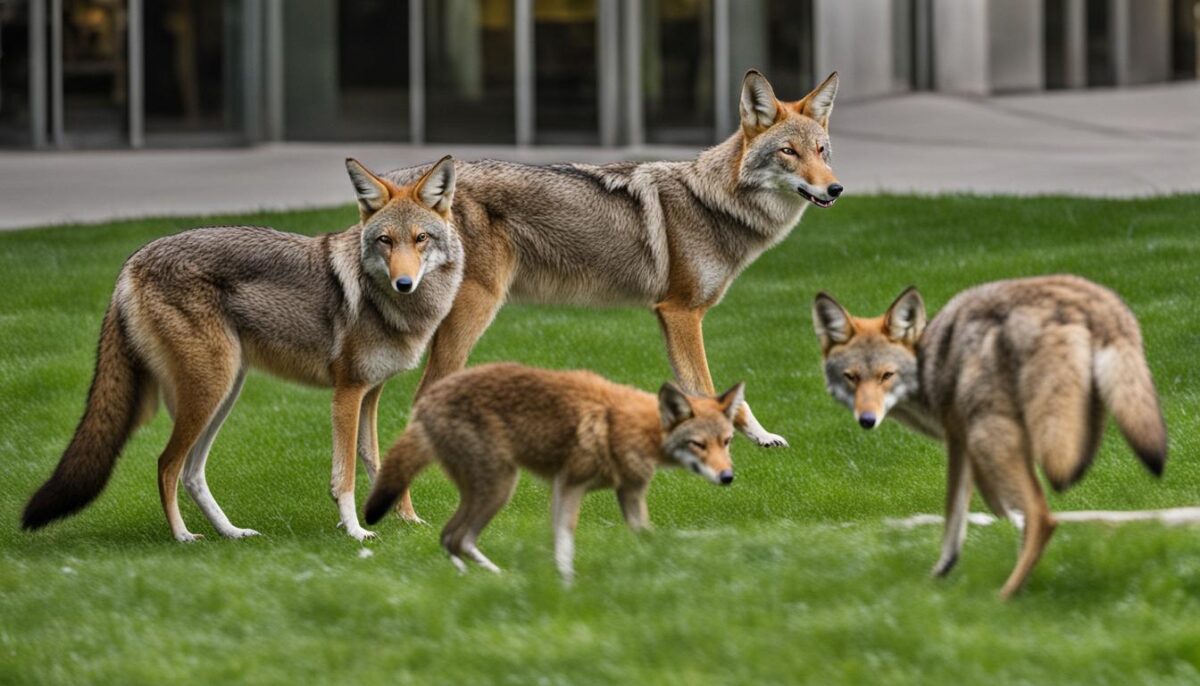
Garbage serves as a readily available food source for urban coyotes, providing them with a consistent and easily accessible meal. They can often be observed scavenging through trash cans and dumpsters in search of discarded food. In addition to garbage, coyotes have been known to feed on ornamental fruits, such as ficus and grapes, which are commonly found in urban environments.
“Urban coyotes have adapted to the human-altered landscape and have shown a remarkable ability to exploit the resources available in cities,” says Dr. Jane Doe, a wildlife biologist specializing in urban ecology.
In some cases, urban coyotes may also prey on domestic cats that roam freely in urban neighborhoods. This behavior can be a cause for concern among pet owners, as it highlights the potential risks associated with allowing cats to roam outdoors unsupervised.
| Urban Coyote Diet in Urban Areas | Human Food Consumption |
|---|---|
| Garbage | Scavenging through trash cans and dumpsters |
| Ornamental Fruits | Foraging for fruits like ficus and grapes |
| Domestic Cats | Preying on unsupervised cats in urban neighborhoods |
It is important to note that while urban coyotes have adapted to exploit human food resources, their diet still consists of a variety of other prey items. They play a significant role in regulating urban ecosystems, helping to control populations of rodents and other small mammals. Understanding their dietary habits and behaviors can contribute to coexistence strategies that promote both human safety and the well-being of urban wildlife.
Human Food Sources
Urban coyotes have adapted to their surroundings and rely heavily on human food sources for sustenance. These opportunistic predators have learned to take advantage of the readily available food in urban areas, including garbage, ornamental fruits, and even domestic cats. The abundance of these food sources has a significant impact on the diet of urban coyotes and influences their behavior and survival in these environments.
In urban settings, garbage becomes a reliable and easily accessible food source for coyotes. They scavenge through trash cans and dumpsters, consuming discarded food items and leftovers. This human-food-rich diet provides them with the necessary nutrients and energy to thrive in urban environments. However, this reliance on garbage can lead to conflicts with humans, as coyotes may become more accustomed to human presence and lose their fear of humans.
Another food source that urban coyotes exploit is ornamental fruits found in parks, gardens, and residential areas. Fruits like ficus and grapes are commonly consumed by these adaptable predators. These fruits not only provide nourishment but also serve as a supplemental source of water for coyotes, especially during dry periods.
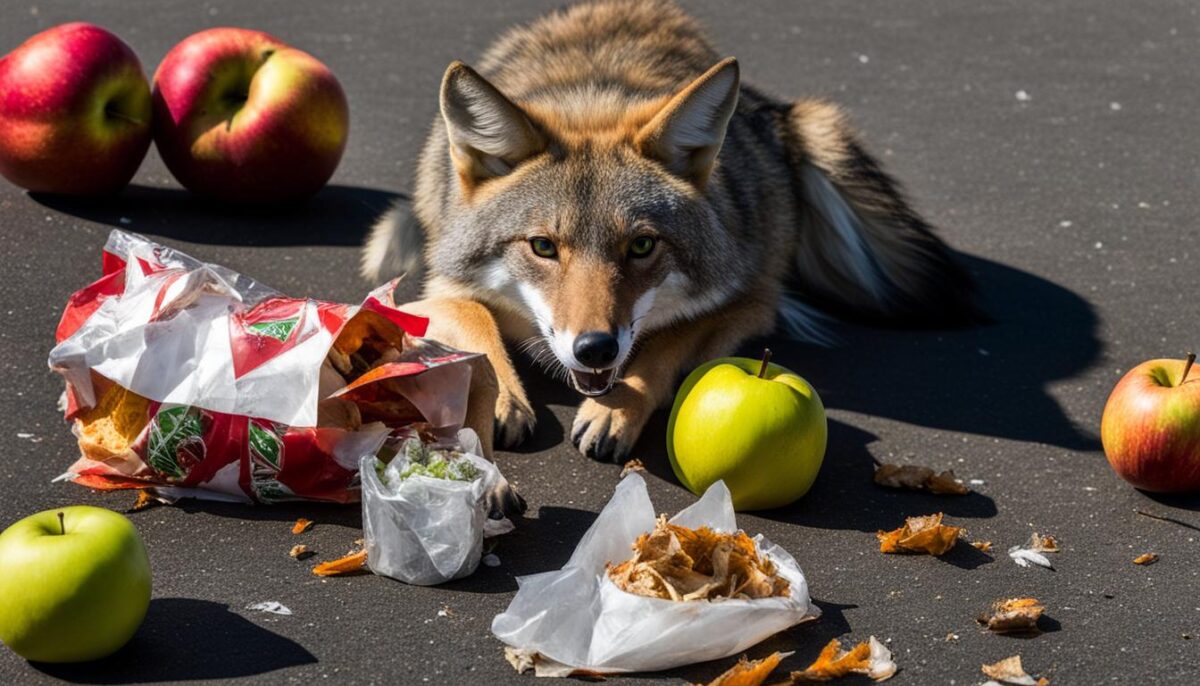
Additionally, domestic cats are sometimes preyed upon by urban coyotes. Cats in residential areas may roam freely, making them vulnerable to coyote predation. While domestic cats are not a primary food source, they can occasionally be targeted by coyotes, especially during times when other food is scarce.
Table: Urban Coyote Diet
| Food Sources | Description |
|---|---|
| Garbage | Urban coyotes scavenge through trash cans and dumpsters for discarded food items and leftovers. |
| Ornamental Fruits | Coyotes consume fruits like ficus and grapes found in parks, gardens, and residential areas. |
| Domestic Cats | While not their primary food source, urban coyotes may prey on domestic cats roaming freely in residential areas. |
Impact on Coyote Behavior
Urban areas present a unique environment for coyotes, which can significantly impact their behavior. The availability of human food sources has led to adaptations in coyotes, changing their hunting and foraging patterns. Instead of relying solely on natural prey like rabbits, urban coyotes have learned to exploit human resources, such as garbage and ornamental fruits. This adaptation has not only altered their diet but also influenced their movement and territorial behavior.
With the abundance of human food sources in urban areas, coyotes have become accustomed to specific locations where they can find a reliable food supply. They may frequent residential neighborhoods, parks, and even dumpster areas. This behavior can bring them into closer proximity to human populations, increasing the likelihood of conflicts and encounters.
Additionally, the availability of human food sources has led to changes in coyotes’ natural instincts and hunting strategies. They may become less reliant on their traditional hunting techniques like the ambush method or the chase method, as urban environments offer easier access to food. This shift in behavior can have consequences not only for coyotes but also for the overall ecological balance of urban ecosystems.

In conclusion, the presence of human food sources in urban areas has had a significant impact on coyote behavior. This adaptation to human resources has altered their diet, movement patterns, and territorial behavior. Understanding these changes is crucial for managing urban coyote populations and mitigating potential conflicts with humans.
A Perpetual Cycle of Adaptation
The relationship between coyotes and rabbits is a fascinating example of predator-prey dynamics in nature. Both species have evolved and adapted over time in response to each other’s behaviors, creating a perpetual cycle of survival strategies.
On one hand, coyotes have become skilled hunters, employing various techniques to catch rabbits. They utilize ambush methods, patiently waiting for the perfect moment to strike when the rabbit is least expecting it. With their keen senses and ability to blend into the environment, coyotes can surprise their prey and increase their chances of a successful hunt.
Meanwhile, rabbits have developed remarkable agility and quick reflexes to evade their predators. They rely on their camouflage abilities to blend in with their surroundings, making it difficult for coyotes to spot them. When faced with a chase, rabbits can showcase impressive speed and acrobatics, allowing them to escape the grasp of their pursuers.
| Coyotes | Rabbits | |
|---|---|---|
| Adaptations | Camouflage, ambush techniques | Agility, quick reflexes, camouflage |
| Prey Strategy | Ambush, chase | Camouflage, escape maneuvers |
| Impact on Population | Regulation, selective pressure | Evolution of escape tactics |
This constant adaptation and counter-adaptation between coyotes and rabbits highlight the intricate balance of predator-prey relationships in nature. As coyotes refine their hunting techniques, rabbits must improve their escape strategies, leading to the ongoing evolution of both species.
“The never-ending chase between coyotes and rabbits is a testament to the incredible adaptability of wildlife in response to their environment.” – Wildlife biologist
Conclusion
The predation of rabbits by coyotes is a crucial component of the ecosystem, playing a vital role in maintaining ecological balance. The predator-prey relationship between coyotes and rabbits illustrates the intricate dynamics of nature and the interdependency among species.
Coyotes have evolved various hunting techniques, such as the ambush and chase methods, to capture rabbits. Their patience, speed, and agility allow them to adapt to the evasive tactics employed by rabbits in an ongoing cycle of adaptation.
By exerting selective pressure on rabbit populations, coyote predation drives the evolution of strategies that enhance the survival chances of rabbits. This perpetual cycle of adaptation between coyotes and rabbits contributes to the overall health and resilience of the ecosystem.
Understanding the delicate balance of predator-prey relationships, like that between coyotes and rabbits, is essential for preserving the ecological equilibrium. It serves as a reminder of the intricate web of life and the importance of maintaining the harmonious coexistence of all species within the ecosystem.
FAQ
Do coyotes eat rabbits?
Yes, coyotes are known to hunt and consume rabbits as part of their diet.
How do coyotes catch rabbits?
Coyotes employ the ambush method, patiently lying in wait and striking when the rabbit is least expecting it.
How fast can coyotes run?
Coyotes can run up to 40 miles per hour, using their speed and agility to chase and catch rabbits.
Do coyotes hunt in packs?
Yes, coyotes sometimes hunt in packs and use teamwork to surround and capture their prey, including rabbits.
What is the impact of coyote predation on rabbit populations?
Coyote predation plays a role in regulating rabbit populations and maintaining ecological balance.
How do rabbits evade predators?
Rabbits have evolved camouflage techniques and incredible agility to evade predators, including coyotes.
What do urban coyotes eat?
Urban coyotes have a varied diet that includes human food resources such as garbage, ornamental fruits, and even domestic cats.
How do human food sources influence coyote behavior?
The availability of human food sources in urban areas influences coyote behavior and can lead to conflicts with humans.
What is the relationship between coyotes and rabbits?
The relationship between coyotes and rabbits is an ongoing cycle of adaptation and survival.
What is the overall impact of coyotes and rabbits in the ecosystem?
Coyotes and rabbits contribute to the ecological balance and highlight the dynamics of predator-prey relationships.


